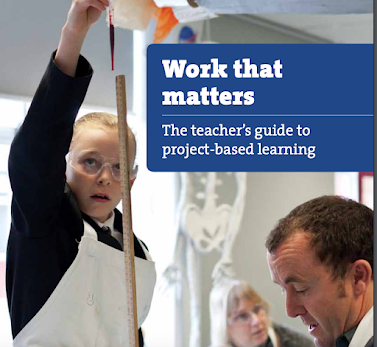EDW:
Engineering Design Workshop
EDW Blog- 2024
EDW Blog- 2023
MIT PBL Courses:
MIT 2.009 Product Engineering Processes( Senior level Course)
Video: An Iconic MIT Class
https://youtu.be/gXTcY0lO-pg
MIT 2.00B-Toy Design(Freshman/Sophomore)
Has 3 skill-building introductory projects, followed by open-ended final design project
Video: Serious Fun at MIT
https://youtu.be/Wey6WrZupLs
Digital Literacy Standards:
ISTE StandardsMassachusetts Digital Literacy Frameworks
Applied Digital Skills:
Adobe AnthemGoogle for Education- Introductory GuidesGoogle Applied Digital SkillsWeVideoCanva
Videos:
“This Will Revolutionize Education”Liberal Education for the 21st Century(Woodie Flowers)Staying on Task During Project-Based LearningPeers, Projects, Passion, Play (Mitchel Resnick):IntroductionThe Lifelong Kindergarten group at the Media Lab, which Resnick leads, seeks to make education at all levels more like kindergarten. Their approach centers around four key principles: projects, passion, peers, and play. They encourage students to work on meaningful projects, follow their passions, collaborate with peers, and adopt a playful, experimental mindset.ProjectsPeersPassionPlay
Drive- Autonomy, Mastery, PurposeMIT Meche on Youtube:
Project-Based Learning:
21st Century SkillsWork that Matters- The Teachers Guide to Project-Based Learning
MyPBL WorksHigh Tech High-Project Design PlaylistJohn Spencer-Project-Based Learning
John Spencer- Incorporating Curiosity into the Classroom
https://spencerauthor.com/7-ways-curious/
Low-Cost Engineering:
Teach Engineering
Playful Engineering (Tufts)Placemat Project GuidesConstructopedia( Tufts CEEO)Building guide using household materials
Dyson Foundation-Challenge Cards
Instructables- STEAM projects for EducatorsTinkering Studio at the Exploratorium
PBS Design Squad(TV Series)
https://pbskids.org/designsquad/
Literature-Based Engineering Challenges:
Novel Engineering( Grades 3-6)Video: https://youtu.be/MHXGvv1sXkIIAM STEM Lesson Library from WPI
Computer-Aided Design:
TinkerCAD (Grades 3-8)Drag+Drop CAD design and circuit designSketchUp (Grade 5+)Browser-based CAD design for architecture and woodworkingOnShape( Grade 7 +)Professional-level CAD program for mechanical design and simulation
Block-Based Coding:
ScratchBlock-Based Coding and StorytellingTelling Stories with ScratchPictoblox( Scratch + AI)Scratch + AI and Machine Learning
Robotics:
Microbit (Microcontroller with built-in features)MakeCode (Block-based Microcontroller coding)Reka-Bit( Breakout board for MicroBit)Lego Spike Prime RoboticsRobot Prototyping system with Scratch Coding
https://education.lego.com/en-us/start/spike-prime/#Introduction
Schools:
NuVu Studio( Studio-Based PBL)High Tech High
PBL EssentialsPBL Videos from HTH
Goals of Project-Based Learning:
Project-Based Learning (PBL) is an educational approach where students engage in exploring real-world problems and challenges over an extended period, while learning academic skills in an authentic context.
The primary goals of PBL include:
1. Enhanced Understanding and Retention:
- Deep Learning: Encourages students to delve deeply into subjects, enhancing their understanding and retention of knowledge.
- Application of Knowledge: Helps students apply what they have learned to real-world situations.
2. Development of Critical Skills:
- Critical Thinking and Problem-Solving: Fosters analytical thinking and the ability to approach and solve complex problems
- Collaboration and Teamwork: Promotes working effectively in teams, sharing responsibilities, and leveraging each other's strengths.
- Communication: Enhances oral, written and digital media communication skills as students present their projects and findings.
- Project Management: Learn how to manage complex projects.
- Helps students develop self-directed learning skills.
3. Increased Engagement and Motivation:
- Relevance: Makes learning more relevant and interesting by connecting it to real-world contexts
- Ownership: Increases student motivation and ownership of their learning as they have a say (“Voice and Choice”) in their projects.
4. Preparation for the Future:
- Life Skills: Prepares students for real-world challenges and opportunities by teaching them essential life skills such as time management, initiative, and perseverance.
- Career Readiness: Equips students with skills that are highly valued in the workplace, such as project management and the ability to work collaboratively.
5. Integration of Interdisciplinary Knowledge:
- Holistic Learning: Integrates knowledge and skills from various subject areas, promoting a more comprehensive understanding of complex issues.
- Cross-Disciplinary Connections: Encourages making connections between different academic disciplines, fostering a broader perspective.
6. Encouraging Innovation and Creativity:
- Creative Thinking: Stimulates creativity and innovation as students design and develop their projects.
- Exploration and Experimentation: Allows students to explore new ideas and experiment with different approaches without fear of failure.
7. Cultivating a Growth Mindset:
- Resilience: Encourages resilience and adaptability by allowing students to face challenges and learn from failures.
- Continuous Improvement: Promotes the idea of continuous learning and improvement.
Overall, Project-Based Learning aims to create a more engaging, effective, and relevant educational experience that prepares students for success in both their academic and professional futures.
Outline of a PBL Project:
KEY KNOWLEDGE, UNDERSTANDING, AND SUCCESS SKILLSThe project is focused on teaching students key knowledge and understanding derived from standards, and success skills including critical thinking/problem solving, collaboration, and self-management. PBL includes direct instruction of fundamental knowledge or technical skills.CHALLENGING PROBLEM OR QUESTIONThe project is based on a meaningful problem to solve or a question to answer, at the appropriate level of challenge for students, which is operationalized by an open-ended, engaging driving question.SUSTAINED INQUIRYThe project involves an active, in-depth process over time, in which students generate questions, find and use resources, ask further questions, and develop their own answers.AUTHENTICITYThe project has a real-world context, uses real-world processes, tools, and quality standards, makes a real impact, and/or is connected to students’ own concerns, interests, and identities.STUDENT VOICE & CHOICEThe project allows students to make some choices about the products they create, how they work, and how they use their time, guided by the teacher and depending on their age and PBL experience.REFLECTIONThe project provides opportunities for students to reflect on what and how they are learning, and on the project’s design and implementation.CRITIQUE & REVISIONThe project includes processes for students to give and receive feedback on their work, in order to revise their ideas and products or conduct further inquiry.PUBLIC PRODUCTThe project requires students to demonstrate what they learn by creating a product that is presented or offered to people beyond the classroom.





No comments:
Post a Comment